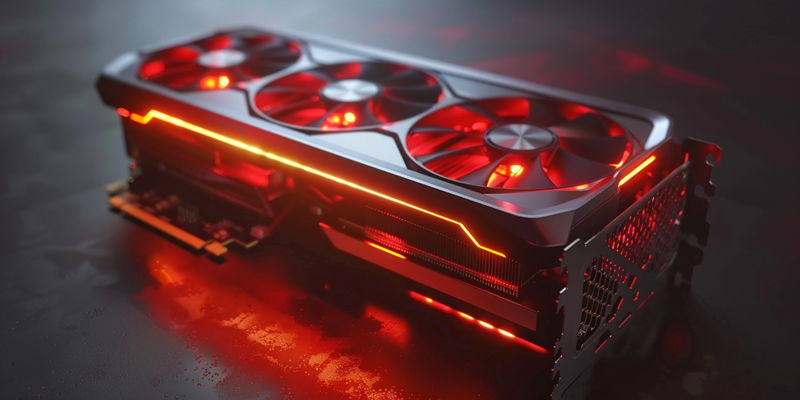In the ever-evolving sphere of PC gaming, a blend of high performance and energy efficiency is the signpost of innovation. The landscape is buzzing with PowerColor’s audacious initiative to plant a Neural Processing Unit (NPU) into their AMD Radeon GPUs—a move that promises gamers not just brute computational prowess but also an intelligent handle on power consumption. This integration stands not merely as a technical enhancement but as a potential revolution in energy efficiency, poised to offer unprecedented power savings of up to 22%. But it’s not just about reducing the electric bill; it’s about recalibrating the very essence of GPU performance.
The NPU-GPU Integration: A Leap in Energy Efficiency
Graphics card technology has always been in a perpetual state of advancement, with manufacturers pushing the envelope in both performance and efficiency. PowerColor’s introduction of an NPU into the AMD Radeon GPUs heralds a novel proposition in this continuum. This isn’t just a typical AI acceleration maneuver. Instead, it hones in on the environmental footprint of PC gaming, slashing power consumption without dampening the adrenaline rush of the gaming experience. It’s an innovative melding of machine learning and thermal dynamics, ultimately translating into cooler, quieter, and more energy-conservative gaming rigs.
Balancing Power Savings and Performance
Striking a harmony between reduced energy draw and gaming performance is at the heart of PowerColor’s innovation. The NPU tailors the GPU’s power profile in real-time, making nuanced adjustments that software solutions simply can’t match. It shows a fine-tuned synergy, trading off a slight dip in frame rates for a significant leap in power savings. For instance, tests with graphically demanding titles like Cyberpunk 2077 and Final Fantasy XV show modest drops in frames per second, but these are so minimal they’re barely perceptible in total gameplay. It’s a compromise many would deem acceptable, especially with the augmented benefit of quieter operation owing to slower fan speeds.
The Technical Underpinnings
This novel approach to NPUs within GPUs highlights PowerColor’s engineering prowess. More than merely accelerating AI processes, the NPU acts as the GPU’s new cerebral cortex, making smart, real-time decisions during gaming that keep power consumption in check. The NPU juggles performance, thermal management, and acoustics, ensuring that gamers can enjoy extended playtime without the concern of high electricity costs or disruptive fan noise. This is all made possible by the NPU’s ability to learn and adapt to each game’s unique demands, bringing an intelligence to power management previously unattainable.
Evaluating the Impact: Benchmarks and Trade-Offs
The real-world impact of PowerColor’s NPU-equipped GPUs can be measured. They’ve been put through power-intensive games, with results showcasing significant reductions in power usage. However, innovations often come with trade-offs. Benchmarks indicate a modest decline in frame rates, which, while a consideration for the performance-minded gamer, still signify a high-quality gaming experience. The delicate balance between power consumption and performance is preserved, matching the priorities of a growing segment of energy-conscious gamers.
A New Perspective on Neural Processing Units
PowerColor’s adaptive use of the NPU within GPUs provides a fresh narrative for hardware optimization, casting new light on neural processing’s role in gaming technology. As the industry moves toward an era where energy consumption is as critical a talking point as performance, an NPU’s ability to optimize power draw in real time sets a forward-thinking precedent. It’s an innovation that not only benefits AMD Radeon GPUs but could potentially challenge the norms of high consumption across the industry.
The Future of AI-Optimized Gaming Hardware
As gamers and manufacturers alike grow increasingly cognizant of the necessity for a balance between power and performance, the integration of AI into gaming hardware is an ever-expanding horizon. PowerColor’s pioneering use of an NPU within a GPU is a glimpse into that future—a promise of not just efficient gaming experiences but also hardware that aligns with wider environmental goals. While it’s uncertain how widely NPUs will be adopted, their potential to rearrange the gaming hardware landscape is unmistakable.
Responding to Consumer Demands for Efficiency
In the dynamic world of PC gaming, innovation is distinguished by a combination of sheer power and mindful energy usage. The current excitement focuses on PowerColor’s bold leap: incorporating a Neural Processing Unit (NPU) into their AMD Radeon graphics cards. This venture isn’t solely about showcasing processing power; it cleverly manages power consumption. The integration of the NPU is more than a simple upgrade—it heralds a potentially game-changing advancement in energy efficiency, granting gamers the prospect of cutting power usage by an impressive 22%. Yet, this development’s significance transcends cost savings; it redefines GPU performance by balancing power with sustainability. As this technology retools how graphics cards perform and use energy, it marks a transformative period in PC gaming where efficiency and power coexist in intelligent harmony.

